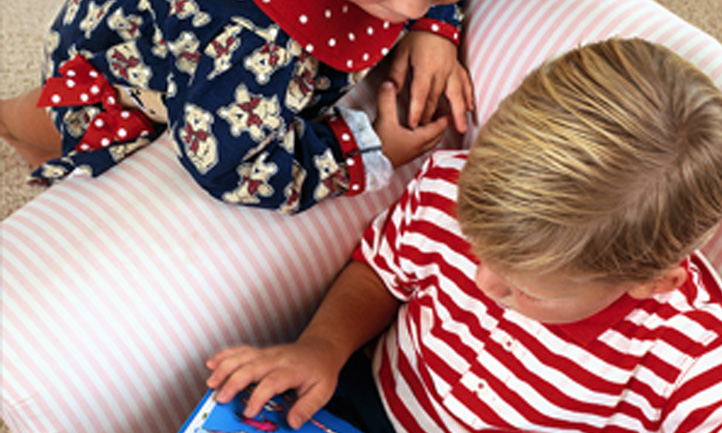Books to Help Your Child
Author: Andrea Hug
When your child faces the death of a loved one, his or her primary support system is profoundly impacted. Your family must find new ways to communicate as you all move through the loss. Sharing your feelings and experiences is really important, and while a direct conversation is good, you may not get as much information as you’d like. You might get only brief answers without thoughtful consideration about how your child really feels.

A “back door” way of addressing a child’s loss is to use story books to allow your child to enter his or her story. Your child can engage the characters in the book and share how a character is “just like me.” Books can offer a comprehensive exposure for your child, giving a wider explanation of the need to tell the story, share feelings, learn about legacy, and capture memories.
Reading stories also expands a child’s vocabulary and allows them to express themselves better. At the same time, you gain insight to what is going on underneath an exterior that doesn’t always divulge the depth of pain. Helping your child understand that he or she is not the only one who feels this way is a gift that has no measure. Each of us needs to know that we are not alone. Reading stories normalizes the chaos of your child’s new situation.
And besides, it’s fun.
With the holiday season upon us, you might consider the following books as gifts for young survivors who are between three and nine years old.
To start a discussion
Children Also Grieve: Talking about Death and Healing ~ by Linda Goldman
Written to be read by adults to children, this book helps open a dialogue about death. The story section about a grandfather who dies provides an opening for the parent and child to examine feelings of fear, anger, and sadness and allows the child to explore what happened in his or her life. Many facets of grief can surface as children share their story while answering questions pertaining to their loss.
To recognize unconditional love
How Do I Love You? ~ by Marion Dane Bauer
Conveying our love for another when we are grieving can be challenging. Yet in this story comparisons are made and metaphors used to express the depth of love the reader has for the person who hears the story. As you read this to your child, you will feel the love between you grow. To extend the story, play a game with the child to find new ways to express love.
The Invisible String ~ by Patrice Karst
This is an endearing story that reminds us that we are never really alone. When we face fear, grief, loneliness, or separation we only have to recall our invisible string joining us to those we love. With simple pictures and soothing colors, the author delivers the message that we are connected to everyone by the invisible string of love. This powerful story touches the heart and reminds all ages how our love binds us together.
The Kissing Hand ~ by Audrey Penn
This story gives children a practical reminder that they are loved and missed in every moment, even when they are apart from the one who loves them. Chester the Raccoon is going to school for the first time and wonders how he will manage without his mother. His mother gives him a gift to help him remember that he is always loved, even when they cannot be together. A story like this helps a grieving child remember that love is always with them in their heart.
To explore feelings
The Rain Came Down ~ by David Shannon
When something unexpected happens that we don’t like, it can affect everything else in life. In this book, a storm comes and triggers one bad thing after another from bad moods to messes that cause people to do things they wouldn’t usually do. This story can help explain how our mood can be affected by unexpected events in our lives. Brainstorming with your child will help build their problem solving abilities. Use the question, “What is another response to this that would make it better?” as you read this story to your little one.
My Many Colored Days ~ by Dr. Seuss
Dr. Seuss does a remarkable thing in this book: he connects children’s feelings with colors so there is a visual experience that a child holds with each color. The pictures are fluid and nondescript just like feelings. This gives your child the opportunity to assign meaning to the colors and connect memory, experiences, and feelings to colors. It is a quick read but can easily be extended through your questions for your child.
To explain life cycles
Saying Goodbye to Daddy ~ by Judith Vigna
When she is picked up early from school by her grandfather, Clara doesn’t understand that something terrible has happened to her father. This story tells about her father’s death and what happens afterward. Written by one of the leading writers for children’s books, the story unfolds through the initial grieving and confusion that ensues. The pictures are drawn and colored in soft, gentle strokes giving comfort through key moments of the grief journey.
I Miss You: A First Look at Death ~ by Pat Thomas
This is a very good book about all that a child faces when a loved one dies. The lifecycle is gently explained and normalized; the process of grieving, funerals, and feelings are explored in an effort to guide a child through his or her own experience. Throughout the book, the author gives the child an opportunity to share about his or her loss by asking the question, “What about you?” Use this book to learn more about what a child is thinking or feeling in the days, weeks, and months after a loss.
To appreciate memories
Always and Forever ~ by Alan Durant
Mole, Hare, Otter, and Fox live together in the forest. When Fox dies, Hare, Otter and Mole grieve his death and cannot find anything to help them through their sadness. One day, Squirrel comes for a visit, and as he talks with them, they remember their special memories of Fox. They laugh again at the special times they shared. In the end, they realize that Fox will always and forever be with them in their hearts.
Chester Raccoon and the Acorn Full of Memories ~ by Audrey Penn
Many young children lose a loved one and need to be taught how to gather their memories to ease their heartache when it becomes especially painful. In this story, Chester’s good friend Skiddil dies. When Chester learns of this, his mother encourages him to make memories so that he will never forget Skiddil. She leads Chester and his friends through the process of recalling special times so that these memories will offer comfort during the times of missing the ones he loved.
To consider as you help your child
Healing the Bereaved Child ~ by Alan D. Wolfelt, PhD
This is a wonderful resource that offers an overview of a child’s grief journey and the developmental issues that a child faces. It provides information for anyone who is in a position to spend time with a child affected by the death of a loved one. Interspersed within the book are key points that help caring adults companion a bereaved child and ultimately grow through grief.
This is a wonderful resource that offers an overview of a child’s grief journey and the developmental issues that a child faces. It provides information for anyone who is in a position to spend time with a child affected by the death of a loved one. Interspersed within the book are key points that help caring adults companion a bereaved child and ultimately grow through grief.
 By Andrea Hug, MaPC, MPS, LCPC: Andrea Hug is the surviving spouse of Lieutenant Christian A. Hug, USNR, a search and rescue helicopter pilot who died in 1993. She holds master's degrees in both Pastoral Counseling and Pastoral Studies from Loyola University in Chicago, and is a Licensed Clinical Professional Counselor. She worked for two years with TAPS Adult Survivor Care Team, having spent the previous six years working in hospice with young surviving widows and children.
By Andrea Hug, MaPC, MPS, LCPC: Andrea Hug is the surviving spouse of Lieutenant Christian A. Hug, USNR, a search and rescue helicopter pilot who died in 1993. She holds master's degrees in both Pastoral Counseling and Pastoral Studies from Loyola University in Chicago, and is a Licensed Clinical Professional Counselor. She worked for two years with TAPS Adult Survivor Care Team, having spent the previous six years working in hospice with young surviving widows and children.
